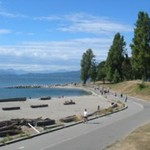 Part of the Stanley Park seawall has been closed since the first big windstorm on Dec. 15, 2006.
Part of the Stanley Park seawall has been closed since the first big windstorm on Dec. 15, 2006.The Vancouver Park Board has approved plans for the restoration of Stanley Park, which has lost thousands of trees to a couple of massive windstorms in the past month.
This means staff will now begin the process of deciding what to do with the fallen trees and ensuring that the park's roads and paths are safe for the public.
They will be faced with a wide range of public opinion on which direction to take.
Thousands of people have written to the board with their suggestions, and about a dozen people offered their thoughts at a meeting Monday night.
"Factors such as human safety and public access must be addressed. To do nothing is not an option," said Ron Rothwell.
"We'd like to see an ecologically based management plan," Patricia Thomson told the commissioners.
"We would further advocate for as natural of a regeneration process as possible," said Stuart MacKinnon.
Jim Lowden, who is heading the restoration effort, said the final plan will take public concerns into consideration, but he warned it won't satisfy everyone.
"I think it's very important to say that one fix does all is not what we're approaching. There will be a variety of different solutions offered," he told the meeting.
"This thing is going to be like a plaid shirt in the sense that there will be overlaid and intertwined solutions for wildlife, for forest floor regeneration, for water runoff, and soil stability. Any one of those will be a different mix of those variables."
Park Board staff will now gather a committee of geotechnical, forestry and environmental experts to carry out a damage assessment and draft a full restoration plan.
That final plan is expected to be completed by the end of March.
Some of the hardest hit areas of the park, including sections of the seawall, won't reopen until at least the summer.



